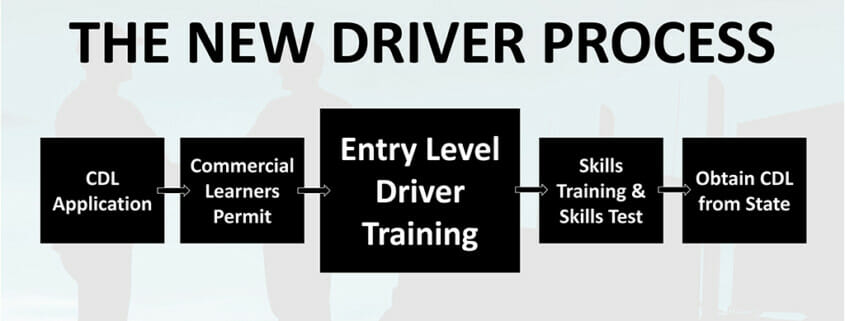What is the ELDT Mandate?
The Entry-Level Driver Training or ELDT mandate is a federally set minimum on requirements from the FMCSA for training entry-level drivers that went into effect February 7, 2022. This mandate is meant for all states to ensure drivers meet at least the federal minimum requirements on ELDT theory and behind-the-wheel training.
The ELDT requirements pertain to new drivers seeking a Class A or B CDL, drivers upgrading from a Class B to a Class A CDL, or drivers seeking a school (S) endorsement, passenger (P) endorsement, or hazardous material (H) endorsement.
Any drivers seeking one of these licenses or endorsements after February 7, will be required to complete the necessary ELDT curriculum to qualify.
What Does the Mandate Change?
The biggest change involved with new ELDT regulations is the Training Provider Registry. The FMCSA requires that all theory and behind-the-wheel training must be completed through an organization listed on their provider registry to ensure they have the necessary curriculum to meet the new standards.
Another part of the regulation is that drivers must score at least an 80% to pass. All ELDT curriculum must be completed before a new driver can take their CDL exam. This will affect all drivers seeking a CDL or endorsement for the first time.
Rumors Around these Changes
There is some confusion about the ELDT changes, and many rumors are out there about how the new mandate will affect drivers, companies, and the transportation industry. These rumors are around the difficulty of complying to the new regulations and the level of federal control.
To get a good understanding of how the ELDT mandate changes will affect you, it’s important to understand what is true and what is false.
Rumor One: Training will Take Longer to Complete with the New Mandates
Many people are concerned these regulations will make training take longer than it did previously. This is not true. There are no required minimum hours to complete training.
As long as you cover every topic required by the FMCSA regulation, you can complete training in whatever timeframe you need. This means online training programs can help drivers complete theory training in less time than traditional training programs and meet all requirements.
Rumor Two: All Drivers Must Redo Training
Some are concerned that drivers will have to redo training to maintain their current CDL or complete all training to upgrade or get an endorsement. This is also not true.
Drivers only have to complete the training required for their specific needs. This means, current CDL holders will not have to complete ELDT curriculum.
This also means drivers looking to upgrade their license from Class B to A or seek an endorsement, will only have to complete the training for those specific areas.
Rumor Three: Federal Requirements Remove State Requirements
Since the ELDT mandate sets federal minimums for training, many believe this will remove any state mandates in place, but this is not true. The federal regulations set a minimum standard for new drivers.
States can add regulations above these minimums. This means it is important for you to check all state as well as federal regulations when it comes to hiring or providing training for entry-level drivers.
What is Involved in ELDT Curriculum?
The theory instruction involved with the new ELDT mandate involves basic operation of the vehicle and safety procedures. Specific theory curriculum required includes:
- Basic Operations
- Safe Operating Procedures
- Advanced Operating Procedures
- Vehicle Systems and Reporting Malfunctions
- Non-Driving Activities
There are also specific curriculum requirements for S, P, and H endorsements which include crash procedures, security, and specific CSA requirements.
Any organization that provides entry-level training is required to register with the FMCSA to ensure training complies with the minimums put in place. This includes schools providing programs, private or other fleets providing internal CDL training, and online training programs.
Internal training programs can also incorporate theory training from another registered organization.
Why Use Online ELDT Theory Curriculum?
Organizations registered with the FMCSA to provide training are subject to audits to ensure they are complying with all mandates.
If your company decides to provide internal training for entry-level drivers, an online training management system like Infinit-I Workforce Solutions can ensure all your documentation is stored and ready to access when needed.
Infinit-I can also take care of all FMCSA reporting requirements for your company. This ensures you never miss a deadline and reduces the stress of compliance with these new regulations.
To see for yourself how easy it is to set up your training with the Infinit-I system, contact us to set up a demo. We can help you meet your training goals, whether it is ELDT, orientation, ongoing, or corrective action training needs.












